Affordable Used Chandeliers: A Comprehensive Guide


Intro
In the realm of interior design, lighting plays a pivotal role that often gets overshadowed by furniture and wall color. It’s the sparkle and shine that can transform a room from dull to delightful. Amidst the myriad of lighting options available today, used chandeliers stand out—not just for their beauty but also for the stories they carry. This guide is all about diving into the world of affordable options, particularly focusing on sourcing and incorporating cheap used chandeliers into your decor.
Far from being mere sources of illumination, chandeliers embody history, elegance, and artistry. Choosing a used chandelier not only elevates your space aesthetically but also contributes to environmental sustainability. The adage "one person’s trash is another’s treasure" rings particularly true in this context. So whether you're a homeowner, an interior designer, or even a tenant looking to jazz up your living space without breaking the bank, this guide aims to provide all the tips and tricks to turn that second-hand chandelier into a stunning focal point in your home.
By the end of this exploration, you’ll be armed with insightful knowledge about styles, sourcing, and maintaining these captivating fixtures, allowing you to make informed choices that resonate with your personal style and values. Get ready to shed some light on how you can brighten up your space while embracing budget-friendly chic.
Understanding Chandeliers
Chandeliers are far more than mere light fixtures; they are true pieces of art that can transform any space. Understanding what chandeliers are, their significance, and their historical context is essential for anyone considering a purchase, especially in the realm of used options. This deeper comprehension not only empowers buyers to make informed choices but also enriches their appreciation of these elegant structures.
When delving into the world of chandeliers, one discovers a tapestry of cultural significance, historical evolution, and design intricacies. Knowing the origins of chandeliers helps in identifying styles that suit personal tastes while also providing insight into their adaptability across various settings. For many homeowners or interior designers, matching a chandelier to a room or theme is key to creating the desired atmosphere, be it formal or relaxed.
Another vital aspect is understanding the quality and craftsmanship behind used chandeliers. Unlike many modern mass-produced fixtures, older chandeliers often showcase unique designs, intricate detailing, and a level of workmanship that is hard to come by today. This uniqueness can add a touch of sophistication and personality to a space without breaking the bank.
Additionally, buying a used chandelier often leads to considerations about sustainability and environmental impact. Opting for second-hand rather than new reduces waste and gives new life to a beautiful item that could have otherwise been discarded. By understanding chandeliers inside and out, buyers can navigate their selections thoughtfully, finding not just a source of light but also a statement piece that reflects both style and values.
"A chandelier is not just a light; it is the heartbeat of a room, breathing elegance and character into any space."
A Brief History
Chandeliers have a long and storied past, tracing back to the Middle Ages. Initially crafted from wrought iron with candles fixed atop, their purpose was purely functional, providing light in large, dark spaces such as cathedrals and castles. These early iterations were often large, with large-scale designs reflecting the status of their owners.
With the advancement of glass-making techniques during the Renaissance, chandeliers began to take on a new form. By incorporating delicate glass prisms that reflected and refracted light, these fixtures became symbols of wealth and opulence. In the 18th century, the introduction of crystal added luster that forever changed the landscape of chandelier design.
Fast forward to the 20th century, and chandeliers began to embrace modernist philosophies, often presenting simplified forms and innovative materials. From Art Deco’s geometric shapes to Mid-Century Modern's minimalistic charm, the evolving styles tell the story of various design periods and movements, influencing how we perceive them today.
Evolution of Design Styles
As society evolved, so did chandelier designs. The various styles that emerged reflect cultural shifts and changing tastes. Traditional chandeliers, adorned with elaborate crystal drops, still evoke a sense of old-world glamor, making them a classic choice for stately homes and dining areas. Many homeowners with vintage houses lean toward these designs to harmonize with the historical architecture.
On the other hand, modern and contemporary chandeliers offer sleek lines and innovative materials. They cater to those with taste that leans more towards the minimalistic or even avant-garde. Common materials include metals like copper or brass paired with industrial elements, making them a popular choice for urban lofts and modern interiors.
Rustic and industrial influenced designs have also gained traction. With a focus on raw finishes and reclaimed materials, these chandeliers can fit beautifully in farmhouses or understated modern homes. They provide a cozy yet sophisticated ambiance, appealing to those looking to embrace a more natural aesthetic.
Lastly, vintage and antique finds have experienced an upsurge in popularity. People today treasure the stories behind these pieces, often seeking chandeliers that speak of a gone-by era. Their unique characteristics often stand out in a world filled with uniformity, appealing to the discerning eye of collectors and decorators alike.
Cultural Significance
Beyond their aesthetic appeal, chandeliers often hold significant cultural importance. They are associated with celebrations, milestones, and communal gatherings. The use of chandeliers in grand ballrooms and banquet halls is a nod to their historical roots within the aristocracy, symbolizing festivity and opulence.
In contemporary settings, chandeliers can be found in both public and private spaces. From exquisite dining experiences in restaurants to intimate gatherings in homes, they play an integral role in shaping atmospheres. The mere presence of a chandelier can elevate an ordinary space, indicating not just light but a sense of occasion.
Moreover, chandeliers often evoke personal memories tied to family gatherings, weddings, or other significant life events. They serve as conversation starters within a home, adding depth to décor while providing a sense of nostalgia and connection to heritage.
Advantages of Buying Used Chandeliers
When it comes to lighting up your abode, choosing used chandeliers might just be the wisest decision, packing a punch in both value and style. Being aware of the distinct advantages can lead you to make educated choices that align with your home improvement goals. Below, each key benefit of buying second-hand chandeliers is laid out, providing a comprehensive view of how this choice elevates your decor while being easy on the wallet.
Cost-Effectiveness
One cannot overstate the financial wisdom of acquiring used chandeliers. These ornate light fixtures often carry a hefty price tag when purchased new, particularly if they’re sourced from high-end retailers. However, purchasing second-hand can mean scoring the same decorative impact but at a fraction of the original cost. For instance, a vintage brass chandelier that may cost several hundred dollars brand new could be found for a mere fraction of that at a thrift shop or online marketplace.
Moreover, this cost-effectiveness isn't merely about the sticker price; it greatly enhances your ability to allocate funds to other house projects or decor pieces. In a nutshell, why pay more if you can snag the same aesthetic charm without burning a hole in your pocket?
Key Points on Cost-Effectiveness:
- Affordability: Find high-quality options without overspending.
- Budget Flexibility: Reallocate savings to other home improvements.
- Resale Value: Some chandeliers may retain or even gain value over time.
Sustainability Considerations
Looking beyond the immediate benefits, buying used chandeliers is a step toward sustainable living. The environmental angle shouldn't be overlooked. Each chandelier saved from the landfill is one less piece contributing to waste. By opting for a pre-loved fixture, you are promoting a circular economy, where the demand for new items diminishes and less energy is consumed in production.
This sustainability ethos ties in with increasing consumer awareness. Now more than ever, individuals are inclined to make responsible choices that benefit the planet. In doing so, you're not just choosing a light fixture, you're advocating for environmental responsibility and supporting efforts to reduce one’s carbon footprint.
"Every time you choose second-hand, you're choosing to have a smaller impact on the earth."
Sustainability Benefits:
- Reduced Waste: Less landfill burden.
- Energy Savings: Lower energy consumption in manufacturing.
- Promoted Awareness: Gesture towards conscious consumption.
Unique and One-of-a-Kind Options
When rummaging through the sea of used chandeliers, you stumble upon a universe of exclusivity. Each piece tells a story and has its own character. Unlike new chandeliers that may have prevalent designs found in every store, used ones often have a charm entirely their own. Picture a French provincial chandelier boasting worn wooden finishes or a crystal fixture dimmed by time, both of which can serve as conversation starters in your home.
This uniqueness not only adds a splash of personality to your residing space, but it enhances the overall aesthetic too. Moreover, hidden gems often carry fascinating histories that can create layers of depth within your interior decor. A piece might even resonate with antique lovers or those with a penchant for curated home elements.
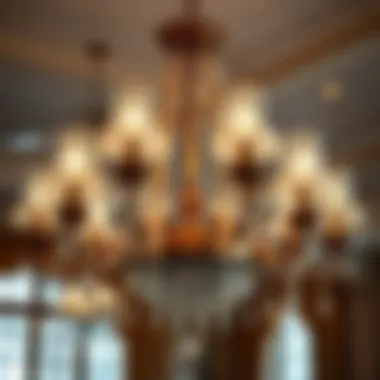
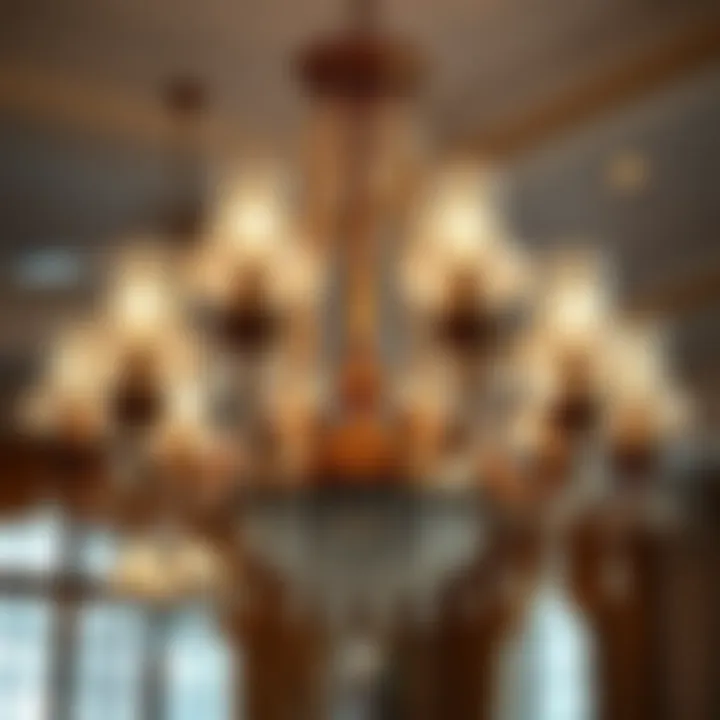
Highlights of Unique Chandeliers:
- Exclusivity: Stand out with a one-off design.
- Character: Embodies stories that elevate the home’s narrative.
- Cultural Heritage: Reflects differing styles from various periods or regions.
In sum, the decision to buy used chandeliers empowers homeowners not only to save money and endorse sustainability but also to invest in unique pieces that reflect personal style. Each of these advantages stacks up to form a compelling case for those considering this decorative endeavor.
Styles of Affordable Chandeliers
In the world of home decor, chandeliers stand out as symbolic pieces that can dramatically influence the ambiance of a room. With various styles available, homeowners and designers can find options that not only fit their budget but also their aesthetic preferences. By understanding the different styles of affordable chandeliers, you can make choices that not only illuminate your space but also enhance its character.
There’s more to chandeliers than just lighting; they can be a focal point, an expression of personal taste, or even a conversation starter. Let’s delve into the various styles that offer charm without breaking the bank.
Traditional and Classic Designs
Traditional chandeliers bring a sense of elegance that can transcend trends. Often crafted from ornate metal and glass, these designs typically feature intricate scrollwork and gemstone embellishments. You’ll find pieces reminiscent of European palaces, adorned with crystals that refract light in enchanting ways.
Here’s what you should keep in mind:
- Material Matters: Brass and bronze finishes are common in traditional designs, adding warmth and durability.
- Scale: A larger chandelier can create a grand statement, particularly in entryways or dining rooms.
- Versatility: While classic, these chandeliers can harmonize with various interior styles — from vintage to modern — if chosen thoughtfully.
To illustrate, imagine a classic wrought iron chandelier, hanging over a rustic wooden dining table, casting a warm glow as friends gather for dinner. This style marries tradition with today’s homey aesthetic seamlessly.
Modern and Contemporary Aesthetics
Modern chandeliers showcase streamlined designs with clean lines and minimalistic elements. They often utilize innovative materials like acrylic or mixed metals, bringing a fresh vibe to any setting. Crystal is often replaced with glass alternatives, leading to lighter impressions without compromising on elegance.
Consider the following when exploring modern options:
- Geometry: Look for shapes that are unique, such as geometric patterns or abstract forms.
- Color Choices: Many modern chandeliers incorporate color schemes like matte black, gold, or monochrome.
- Functional Lighting: Focus on designs that offer both task and ambient lighting, perfect for open-concept spaces.
For example, a sleek metallic chandelier with an asymmetrical design can serve as a stunning centerpiece in a contemporary living room, creating a focal point that exudes sophistication.
Rustic and Industrial Influences
Chandeliers with rustic or industrial influences are all the rage, especially among those drawn to the charm of reclaimed materials. Wooden beams, exposed bulbs, and metal accents create a cozy yet edgy feel. The beauty of these styles lies not just in how they look but in the narrative they convey — often reminiscent of warehouse and barn aesthetics.
Key elements to consider:
- Material Contrasts: A mix of wood and metal can bring depth and texture.
- Bulb Choices: Vintage Edison bulbs or LED alternatives work well in this style, providing an inviting glow.
- Installation Space: Perfect for lofts, farmhouses, or cozy cafes, the right chandelier can enhance the industrial vibe.
Picture a chandelier made of reclaimed barn wood and black iron, strategically placed in a sunlit corner of a cozy living room. It creates an inviting atmosphere that feels both lived-in and stylish.
Vintage and Antique Finds
Vintage and antique chandeliers offer a treasure trove of stories, often embodying craftsmanship that’s hard to replicate today. These pieces not only light up a room but also serve as historical artifacts, each with unique designs from different eras. Finding these gems at thrift stores or auctions can be thrilling.
When hunting for vintage chandeliers, consider:
- Patina and Wear: Don’t shy away from items showing slight signs of age; they add character.
- Details: Look for distinctive elements, like hand-painted glass or artisan engravings, that tell tales of yesteryears.
- Compatibility: Ensure that the vintage piece fits with your home’s existing decor without clashing.
Imagine an antique crystal chandelier hanging gracefully in a modern apartment, its vintage allure providing a striking contrast to sleek furniture. It becomes more than just a light fixture; it's a centerpiece.
Recognizing the different styles of chandeliers allows you to appreciate their role in your decor choices. Whether you’re drawn to the graceful elegance of traditional designs or the edgy vibe of industrial pieces, affordable options abound to suit every taste.
Where to Find Cheap Used Chandeliers
Finding affordable used chandeliers can feel like hunting for hidden treasures. The pursuit doesn't just provide cost savings, it also opens doors to a world of unique designs and stories that new pieces simply can't replicate. Whether you're revamping your home or just on the lookout for a charming addition to your space, knowing where to search is half the battle.
Local Thrift Stores and Flea Markets
Thrift stores and flea markets are often bustling with activity, making them a perfect starting point for chandelier hunting. Here, customers can discover an eclectic mix of items, often with little competition from others seeking lighting fixtures. Since inventory is constantly changing, frequent visits can yield great finds.
When rummaging through thrift shops or market stalls, keep your eyes peeled for various styles of chandeliers. Sometimes they can be tucked away in dark corners or mixed in with unrelated items. It's worth the effort to ask store employees about any upcoming shipments or backroom treasures.
Benefits of Thrift Stores and Flea Markets:
- Cost-Effective Prices: Often, chandeliers at these locations are significantly cheaper than retail. Expect to pay less than you would for a similar piece at a boutique or online shop.
- Unique Options: You may stumble upon styles that are no longer in production, making your purchase one of a kind.
- Local Finds: Supporting your community not only helps local businesses but it's more sustainable as well.
Online Marketplaces
The digital era has made the search for used chandeliers easier than ever. Online marketplaces such as Facebook Marketplace, Craigslist, and eBay provide a vast selection of lighting fixtures from various sellers. This is ideal for those who prefer browsing from the comfort of their home.
However, it's crucial to approach online purchases with caution. Always examine listings closely for details about the chandelier's condition and ask the seller questions if anything seems amiss.
Key Aspects of Online Marketplaces:
- Wider Selection: With just a few clicks, you can access numerous listings from different regions, vastly expanding your choices.
- Price Comparisons: Quickly compare prices and quality between listings helps ensure you’re getting your money’s worth.
- Direct Communication: Reach out to sellers to negotiate prices or clarify details.
Estate Sales and Auctions
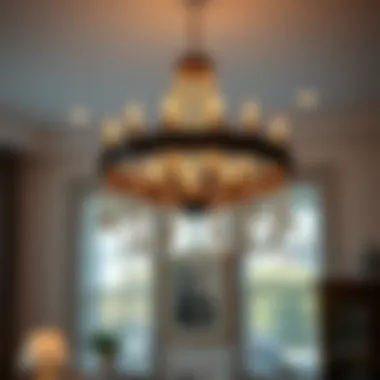
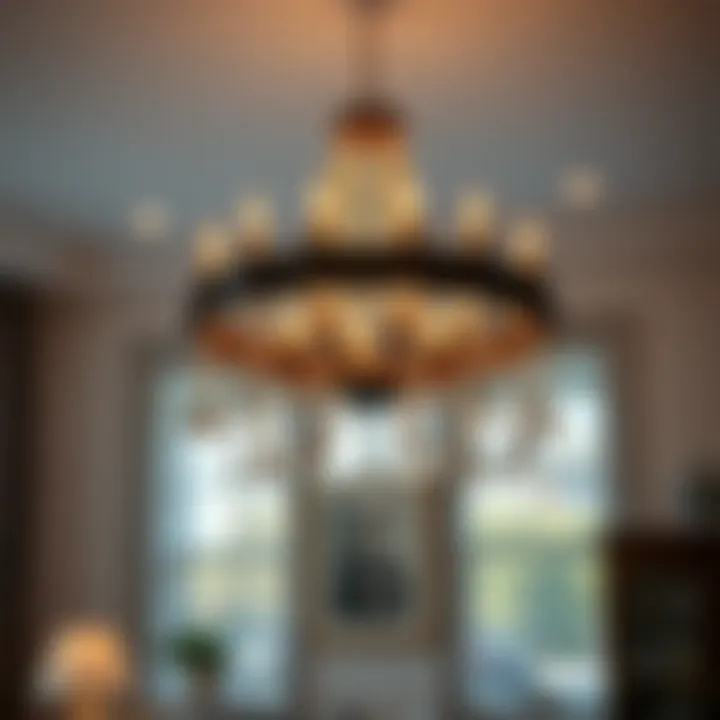
Estate sales and auctions can feel like a gold rush for unique chandelier finds. These events often occur when individuals are downsizing or relocating, leading to high-quality items being sold off. Sometimes, chandeliers are sold as part of a larger lot, providing an opportunity to grab a great deal if you're willing to put in the time.
Attending estate sales or auctions can take some preparation. It’s beneficial to research upcoming events in your area and arrive early to get the first pick.
Considerations for Estate Sales and Auctions:
- High-Quality Items: Many chandeliers found at estate sales have been well cared for, often made from better materials than similar-priced items in retail stores.
- Bargaining Opportunities: Auctions, in particular, allow for some degree of negotiation, which can lead to finding true steals.
- Stories Behind Pieces: Each chandelier comes with its own history, and learning about its background can enhance its value in your home.
To truly score a unique piece, keep a keen eye on community events and local resources for updates on where you can find these hidden gems.
Evaluating Used Chandeliers Before Purchase
Before snapping up a used chandelier, evaluation is essential. Unlike a new purchase from a store, a second-hand option comes with its own set of quirks and stories. So, this section takes a closer look at the key factors to keep in mind when on the shopping hunt. Proper evaluation can save you from future headaches while ensuring that your choice enhances your space aesthetically and functionally.
Assessing Condition and Quality
It's easy to get caught up in the allure of a vintage chandelier—the way its crystals catch the light or how its design whispers tales of eras gone by. However, before letting your heart take the wheel, you must assess its condition and quality. Here’s what to consider:
- Physical Damage: Look for cracks, chips, or significant scratches on the materials. If it’s a glass chandelier, even small chips can affect how light is dispersed. Similarly, check for any missing parts;
- Material Composition: Chandeliers come in various materials like crystal, glass, metal, and even wood. Each has distinct maintenance requirements. For example, crystal needs careful cleaning, while metal might require polishing;
- Functionality: Ensure that the wiring and sockets are intact. A chandelier that doesn’t work is like a ship without a sail—beautiful but ultimately pointless. Testing the light fixtures is crucial;
- Age and Wear: Take into account how much wear the chandelier has endured over the years. A well-preserved antique can be a treasure, while one that’s falling apart is a disaster waiting to happen.
It's vital to strike a balance between aesthetic appeal and practical usability when assessing condition and quality.
Identifying Authenticity and Age
A chandelier’s charm often lies in its history. Thus, determining authenticity and age adds a layer of meaning to your purchase. Knowing what you're buying can also impact its value. Here’s how to go about it:
- Check for Maker’s Marks: Many high-quality chandeliers come with stamps or labels from their original manufacturers. These marks can give insights into its maker and period;
- Research Design Styles: Familiarize yourself with different chandelier designs and styles from various periods. Knowing what you’re looking at can help identify whether it's a cheap reproduction or a genuine antique;
- Materials Used: Vintage chandeliers often use materials that aren’t commonly found today, such as hand-blown glass or specific types of metals. If it looks too new, it might not be the authentic deal;
- Documentation: If you can, ask for any provenance or history related to the piece. Previous ownership or restoration records usually add value and lend credibility.
Identifying authenticity and age adds depth to your purchase, ensuring it isn't just a pretty face in your decor.
Restoration and Maintenance of Chandeliers
When it comes to enhancing the ambiance of a room, a well-maintained chandelier can make all the difference. This section emphasizes the importance of restoration and maintenance, particularly for used chandeliers, as they often bear the marks of time. Neglecting these tasks can lead to an inevitable decline in both aesthetic appeal and functionality. Therefore, being proactive about care and repair is key.
Maintaining a chandelier isn’t merely about keeping it clean. It’s about prolonging its life and ensuring that it continues to operate safely and optimally. Regular maintenance can help you spot issues before they become costly problems, preserving not just the beauty but also the value of your chandelier.
Investing time and effort into restoration can create an heirloom piece, often with a story behind it—something unique that speaks to your character. Plus, the trend towards vintage aesthetics in modern design means that an older chandelier can serve as a statement piece that resonates with the ongoing nostalgia for previous design eras.
Here are some considerations on how to effectively restore and maintain your used chandelier:
- Understand the materials involved. Different materials require distinct cleaning solutions and techniques.
- Regularly inspect for wear and tear such as frayed wiring, loose connections or tarnished finish.
- Don’t shy away from consulting a professional when a restoration task seems beyond your skill set.
By maintaining your chandelier, you're also investing in sustainability. A well-loved chandelier can last many more years than a new, cheaply made one, keeping unnecessary waste out of landfills.
Cleaning Techniques for Different Materials
Cleaning is fundamental when it comes to restoration, but the technique you employ will depend largely on the material your chandelier is made from. Here’s a handy guide:
- Crystal Chandeliers: Use a mix of warm water and mild dish soap. Gently wipe down each crystal pendant with a soft lint-free cloth, and avoid any harsh chemicals that could dull the shine. Alternatively, for a sparkle, a solution of vinegar mixed with water can work wonders.
- Metal Chandeliers: For brass or bronze, use a soft cloth and a mixture of vinegar and water; this can help remove tarnish. Rinse with water and dry thoroughly to avoid spots. If your chandelier is painted, use only dry cleaning methods to avoid removing the paint.
- Glass Chandeliers: Similar to crystal, glass requires a gentle touch. Opt for window cleaner but ensure it’s streak-free for that crystal-clear appearance.
Remember to never immerse any chandelier directly in water—this can lead to electrical issues. Dusting frequently will also make deep cleaning easier and less necessary.
Rewiring and Safety Checks
Safety should always be a top priority when dealing with electrical fixtures. Over time, the wiring in older chandeliers can degrade. If you notice flickering lights or strange smells, it’s time to address potential rewiring. Here are practical steps to keep your chandelier safe:
- Inspect wiring regularly. If you see exposed wires or fraying, replace them or consult a professional.
- Check connections. Ensure all bulbs are secure and that the fixture is tightly attached to the ceiling.
- Consider upgrading the LEDs. Not only do they save energy, but they also produce less heat, reducing wear on the overall fixture.
If rewiring seems intimidating, professionals can handle it efficiently. Make sure the technician specializes in vintage lighting fixtures so that they respect the heritage of your chandelier while ensuring its safety.
In summary, restoration and maintenance can significantly enhance the lifetime and aesthetics of used chandeliers. By adopting careful cleaning techniques and prioritizing safety checks, you’ll enjoy the dazzling charm of these fixtures for years to come. Not only will you be preserving a piece of art, but you’ll also be enriching your living space while contributing to sustainability—a true win-win.
Incorporating Chandeliers into Various Spaces
Integrating chandeliers into different spaces involves more than simply hanging a decorative light fixture. It’s about creating an atmospheric experience that resonates with the function and aesthetic of each room. Chandeliers serve not only as a source of illumination but also as the focal point that can define or enhance a space's character. When chosen wisely, a chandelier can become the jewelry of a room, adding depth and elegance. Let’s delve into how to incorporate chandeliers into various home environments effectively.
Living Rooms and Family Areas
In the living room, a chandelier can bring a touch of sophistication that lifts the overall decor. A larger, eye-catching piece can act as a statement, especially in open-concept layouts where it might be viewed from multiple angles. To avoid overwhelming the room, consider selecting a chandelier that complements the existing furniture and color scheme.
- Scale Matters: Choose a chandelier that matches the size of the room. An oversized piece in a small room may feel oppressive, while a small fixture in a spacious area may become lost.
- Harmonizing Styles: Traditional crystal chandeliers pair well with classic furnishings, while minimalist designs can enhance contemporary setups. Mixing styles can also create a unique look, so don’t be afraid to experiment.
- Layered Lighting: They should be part of a layered lighting approach, where combination of ambient, task, and accent lighting creates a balanced and inviting atmosphere.
Dining Rooms and Kitchens
In dining areas, chandeliers are not merely decorative but also functional. A well-placed fixture can elevate the dining experience.
- Height Consideration: Hang your chandelier at a height that allows for conversation without obstructing views. As a rule of thumb, aim for 30 to 36 inches above the table.
- Material Choice: Opt for rated fixtures, particularly in kitchens, where moisture can pose a risk. Materials like metal or glass are durable and easy to clean.
- Creating Ambience: Dimming capabilities can enhance the dining experience, allowing for bright lights during meals or softer touches for intimate dinners.
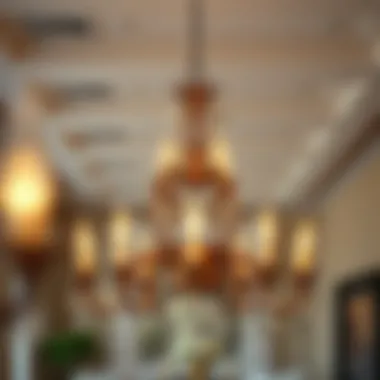
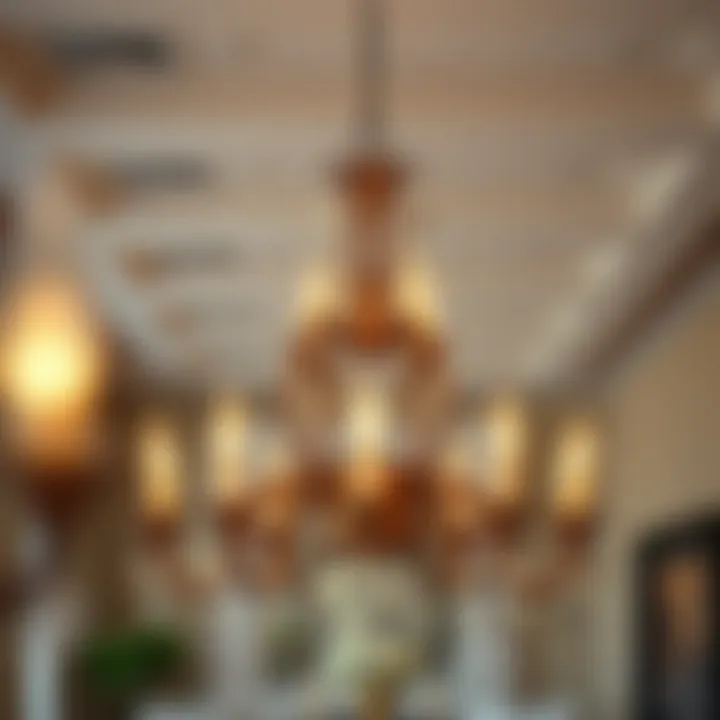
Bedrooms and Personal Spaces
Chandeliers in bedrooms can add a romantic or luxurious feel. Their placement and style should reflect personal taste and the room's function.
- Soft Glow: Choose fixtures that emit softer light, creating a calming environment conducive for relaxation. Consider options like fabric shades that diffuse light gently.
- Artwork Integration: A decorative chandelier can complement or enhance artwork in the room, tying the whole design together.
- Functionality: Ensure that chandeliers in bedrooms don’t overpower the space. They should serve as supplementary lighting, combined with bedside lamps or recessed ceiling lights for versatility.
Home Offices and Study Areas
In home offices and study areas, chandeliers can transform mundane workspaces into inspiring environments.
- Inspiration Over Illumination: Go for artistic designs that spark creativity. The chandelier should harmonize with other design elements like wall color and desk style.
- Practical Height: Consider the clearance above the desk. A chandelier that is too low can be distracting, while one hung too high might not provide sufficient light.
- Personal Touch: Using a used chandelier can reflect individual style and set the tone for productivity, making the workspace feel more personalized and enjoyable.
"Lighting is the key to creating the right ambiance in any space; chandeliers can do that beautifully while adding style."
Chandeliers, when incorporated thoughtfully, can be the icing on the cake for any room, providing much more than just light. They hold the power to transform spaces subtly yet significantly, making the home feel both stylish and inviting.
Design Trends in Chandeliers
The world of chandelier design is constantly evolving, blending timeless appeal with modern sensibilities. The significance of understanding design trends in chandeliers cannot be overstated, especially for homeowners and designers looking to make impactful choices without breaking the bank. Keeping abreast of these trends helps in selecting the right piece that can complement existing decor while reflecting personal style. Moreover, trends can signal the resurgence of classic styles or the birth of entirely new aesthetics that may suit various spaces.
Contemporary chandeliers now embrace forms and materials that speak volumes of sophistication. Understanding these trends not only aids in directing purchasing decisions but can also enhance the overall ambiance of a home. Let’s dive into two prominent directions shaping chandelier design today: minimalism and eclecticism.
Minimalism and Simplified Forms
Minimalism, with its mantra of 'less is more,' has seeped into chandelier designs, showcasing simple shapes and clean lines. These designs often harmonize with the concept of open spaces and airy environments. A minimalist chandelier tends to use fewer elements, allowing the existing design features of a room to shine. This is especially beneficial for smaller living areas where cumbersome fixtures may overwhelm the space.
When selecting a minimalist chandelier, consider these key aspects:
- Materials: Look for those made from metals like brushed nickel or matte black finishes. Glass shades can also add a touch of elegance without being too extravagant.
- Shapes: Geometric forms, such as spheres or angular designs, are common in minimalist chandeliers. This adds a contemporary flair while retaining functionality.
- Light Sources: Energy-efficient LED bulbs can be beneficial, casting soft light without the need for excessive ornamentation.
A minimalist chandelier can serve as a focal point while integrating seamlessly into the broader design of a room. It exemplifies the principle of efficiency in aesthetic appeal, merging utility with subtle elegance.
Eclectic and Maximalist Approaches
On the other end of the spectrum, eclectic and maximalist styles embrace a more layered approach to design. This trend reflects personal taste often pulling from various historical periods or unrelated design styles. Here, the idea is to create a vibrant, unique expression that tells something about the occupant's personality.
Considerations for choosing an eclectic chandelier include:
- Mix of Materials: Eclectic designs often utilize a variety of materials from metal and crystal to wood, providing a rich textural experience.
- Color Palettes: Bold colors and contrasting finishes are hallmarks of maximalist chandeliers. These choices allow for more vibrant statements in a living space.
- Ornamental Features: Look for chandeliers that have intricate details like beading, pendants, or layers of different shapes. This will provide visual interest and create a conversation starter.
Maximalist chandeliers can transform ordinary spaces into extraordinary ones, compelling your guests to delve deeper into the design narrative that each piece conveys.
In essence, whether one leans toward minimalism or embraces eclecticism, understanding these design trends ensures that your chandelier choice resonates not just with your personal style but also with the essence of the home.
As you consider incorporating a used chandelier into your home, be mindful of how these styles interact to create beauty and functionality, striking a balance between modernity and tradition.
Budgeting for Used Chandeliers
When diving into the world of used chandeliers, having a budget in mind can mean the difference between a smart purchase and a regrettable financial decision. Understanding your budget not only helps you focus on what you really want, but it also streamlines the search process. Chandeliers discuss as both functional lighting fixtures and works of art, and that dual nature can sometimes muddy the waters of pricing. Therefore, having a solid plan is crucial for both homeowners and decorators alike when looking into second-hand options or vintage styles.
A well-thought-out budget ensures that potential buyers spend sensibly, allowing for choices that won’t strain their finances. It's not just about the initial outlay; you also want to take maintenance costs and potential restoration into account.
Establishing a Price Range
The first step in budgeting is defining a price range. Chandeliers can span a wide array of prices, from a mere fifty dollars at a local thrift shop to thousands for a rare, antique type. To zero in on what you’re willing to spend, start by:
- Identifying your financial limits. What’s the maximum you can put on the table without breaking the bank?
- Researching comparable chandelier prices online or in showrooms. Sites like eBay or Etsy often have previously owned items listed, giving a realistic idea of the going rates.
- Considering the type of chandelier. A sleek modern piece might come at a different price point than something with grand, traditional flourishes.
By taking these points into account, you create a sensible budget framework that aids in narrowing down choices efficiently. Ultimately, having a defined price range saves time and frustration.
Understanding Value vs. Cost
Now, let’s ponder a more nuanced aspect of budgeting—understanding value versus cost. It’s easy to fall into the trap of seeing a good price and jumping for it without considering whether it’s genuinely worth it.
- Cost is straightforward; it’s the price you pay for the chandelier.
- Value, on the other hand, is more abstract. It encompasses the quality, style, and longevity of the chandelier, along with how it fits into your overall décor.
For instance, a chandelier priced at three hundred dollars might seem steep at first glance. Still, if it’s made of high-quality materials and will last decades, it’s a worthy investment. On the flipside, a low-cost chandelier might quickly require replacements or repairs, costing you more in the long run.
"A wise buyer knows that the most economical choice is not always the cheapest."
To help navigate this landscape:
- Prioritize chandeliers that reflect your personal style and needs.
- Look into the history or brand reputation. This can give insights into the quality you can expect.
- Factor in any necessary upkeep or repairs. A chandelier needing extensive work may hold less value despite a low purchase price.
In summary, budgeting for used chandeliers goes beyond just finding a cheap deal. Propering the intricacies of cost versus value lets homeowners and designers make informed decisions that elevate their spaces beautifully and sustainably.
Closure and Final Thoughts
In wrapping up the exploration of cheap used chandeliers, it becomes clear that these elegant fixtures offer far more than mere illumination. They can serve as pivotal design elements, enhancing the visual appeal of any room. Appreciating the significance of chandeliers in both historic and modern contexts helps one to recognize their potential beyond simple functionality.
Considering the myriad benefits associated with purchasing second-hand chandeliers, it’s valuable for homeowners, interior designers, or anyone with a creative touch to seriously engage in this space. Not only does buying used save money, but it also promotes sustainability. It is a choice that resonates considerably with environmental ideals. Opting for older pieces often leads to finding unique designs that cannot be found in today’s mass-produced offerings. Additionally, each chandelier holds a story, a history that new ones simply cannot replicate.
As mentioned throughout this article, there are key steps to consider when embarking on this vintage decor journey. Understanding the type of style that fits a space, evaluating condition prior to purchase, and mastering maintenance techniques will all contribute to making the right choice. These chandeliers can truly shine in various settings, be it a cozy living room, an upscale dining area, or even a functional workspace.
Moreover, keep in mind the joy of the hunt. Scouring flea markets, estate sales, or online marketplaces adds an element of adventure to the process. Encountering a hidden gem that speaks to the soul can make the entire effort worthwhile.















